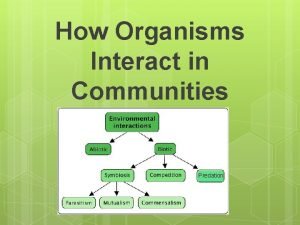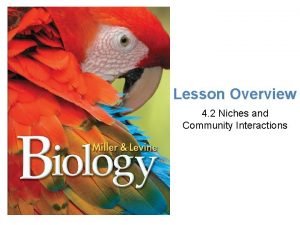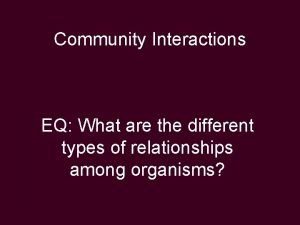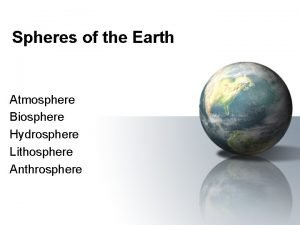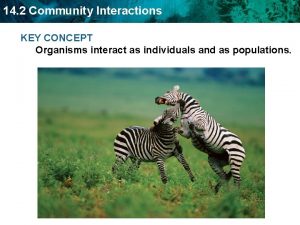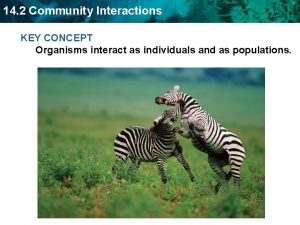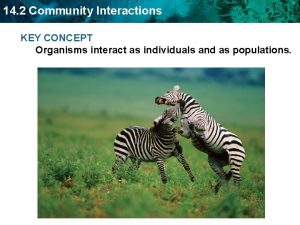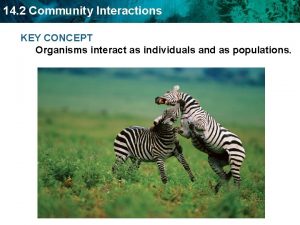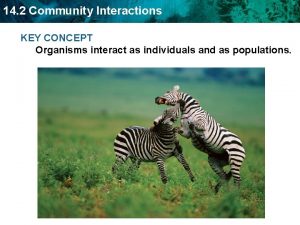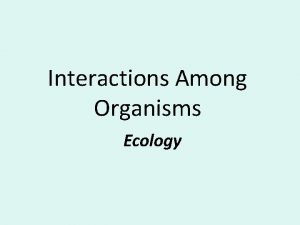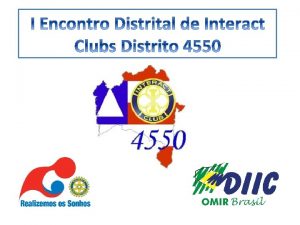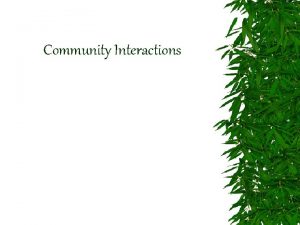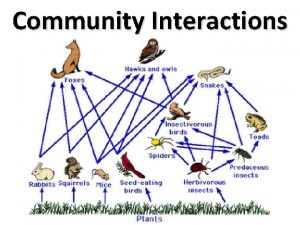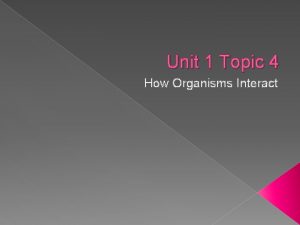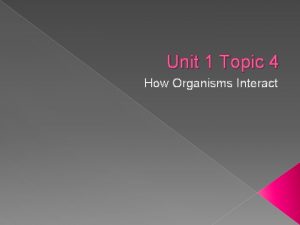14 2 Community Interactions KEY CONCEPT Organisms interact












- Slides: 12

14. 2 Community Interactions KEY CONCEPT Organisms interact as individuals and as populations.

14. 2 Community Interactions Competition and predation are two important ways in which organisms interact. • Competition occurs when two organisms fight for the same limited resource. – Intraspecific competition – Interspecific competition

14. 2 Community Interactions • Predation occurs when one organism captures and eats another.

14. 2 Community Interactions • There are three major types of symbiotic relationships. – Mutualism: both organisms benefit

14. 2 Community Interactions • There are three major types of symbiotic relationships. – Commensalism: one organism benefits, the other is unharmed Ø Human Our eyelashes are home to tiny mites that feast on oil secretions and dead skin. Without harming us, up to 20 mites may be living in one eyelash follicle. Commensalism Ø Organism is not affected + + Organism benefits Demodicids Eyelash mites find all they need to survive in the tiny follicles of eyelashes. Magnified here 225 times, these creatures measure 0. 4 mm in length and can be seen only with a microscope.

14. 2 Community Interactions • There are three major types of symbiotic relationships. – Parasitism: one organism benefits, the other is harmed 0 Parasitism _ + Hornworm caterpillar The host hornworm will eventually die as its organs are consumed by wasp larvae. _ Organism is harmed 0 Braconid wasp Braconid larvae feed on their host and release themselves shortly before reaching the pupae stage of development. Organism benefits

14. 2 Community Interactions • There are three major types of symbiotic relationships. – Parasitism meet their needs as ectoparasites (such as leeches) and endoparasites (such as hookworms)

14. 2 Community Interactions Two robins eating worms is an example of A. B. C. D. Mutualism Commensalism Competition Parasitism

14. 2 Community Interactions Predation is best described as A. One organism capturing and eating another B. Two organisms competing for limited resources C. An interaction in which two species benefit from one another D. An interaction in which one species benefits and the other is not affected

14. 2 Community Interactions Aphids eat the sap from plants and excrete sticky waste that ants eat. The ants protects the aphids from predators. This type of interaction is called A. B. C. D. Mutualism Commensalism Competition Parasitism

14. 2 Community Interactions An oak tree provides a sparrow a place to build a nest. The nest neither benefits or harms the tree. What is the name for this type of relationship? A. Mutualism B. Commensalism C. Competition D. Parasitism

14. 2 Community Interactions One difference between parasitism and predation is that parasites A. B. C. D. Do very little to harm their hosts Keep their hosts alive for a period of time Attack the host only from the inside Are not very big
 Member of the same species
Member of the same species How organisms interact in communities answer key
How organisms interact in communities answer key What are abiotic organisms
What are abiotic organisms 6.1 habitats niches and species interactions
6.1 habitats niches and species interactions Niches and community interactions
Niches and community interactions Parasitism
Parasitism Unicellular vs multicellular activity
Unicellular vs multicellular activity Minerals concept map
Minerals concept map Lesson 1 introduction to waves
Lesson 1 introduction to waves Business canvas example
Business canvas example Contoh bisnis model canvas makanan pdf
Contoh bisnis model canvas makanan pdf Layers of the sun
Layers of the sun How does biosphere interact with hydrosphere
How does biosphere interact with hydrosphere

